‘Opening up’ at the common
-374x249.jpg)
Before the car invasion
The coming of the motor car caused changes in the appearance of the village. Cars started to appear in the early years of the century: there were complaints about speeding in 1913. It is recorded that cars, ‘opening up’ at the top of the common, had frequently reached a speed of 40 miles an hour by the time they reached the Old Bell.
Comfy Cars
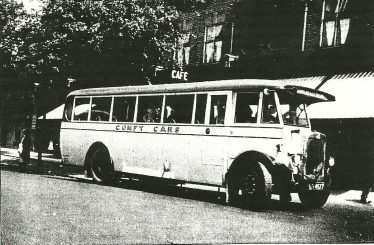
Comfy Cars bus
The first bus service was started in 1910 by a group of Luton businessmen, who bought three second hand buses from a London operator, and ran them between Luton and St Albans. In the early days they did not run on Sundays. By the early 1930s there were three separate operators running through the village, including Harpenden’s own Comfy Cars, who had a depot on the Luton Road, where Ogglesby’s Garage was until recently.
Traffic problems
The number of cars had grown dramatically, and in the late 1920s and early 1930s there were many schemes to ease the flow of traffic around the village. Sun Lane was widened and the so called Toll House cottages which protruded into the High Street just south of Sun Lane were pulled down. In 1928 the Cock Pond was filled in and the small stream along the Lower High Street was piped underground. At Southdown, the junction of Southdown Road with Piggottshill Lane was widened, and many of the lanes around the village centre had awkward bends removed. We may, perhaps, be permitted a wry smile that many of the same roads have now had traffic calming schemes installed to slow the motor car down!
1930s
The 1930s was a particular time of change in the High Street. The east side between Thompsons Close and Vaughan Road was extensively rebuilt. The Old Brewery had covered much of the site: it was replaced by the Methodist Church and shops.
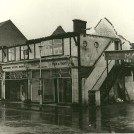
Buildings near Broadway Hall being demolished
Broadway Hall, the covered market, was built in 1933 on the site of an old cottage (Bowers cottage, part of Bowers Farm). It has since been replaced by Sainsbury’s. At the same time, on the other side of the High Street, the block between Lloyds Bank and The White Lion was completely rebuilt.
After World War II
The people of Harpenden celebrated the end of the war in Europe with a united Civic Service at the Parish Church, followed by a series of bonfires all over the village, each area trying to have the biggest. The following day there were numerous street parties and teas for the children, before people settled down to restoring life to normal.
A need for new housing
The first need was for housing. House building had been at a standstill during the war, but the population had increased by nearly 3,000 over its pre-war total of about 11,000. In addition men and women were returning from the Forces, all of them wanting somewhere to live. The Urban District Council began development of the Batford Estate, for which plans had been made before the war. 200 houses were to be built there. As a temporary measure, when the German prisoners were repatriated, families were moved into the Prisoner of War Camp at Batford, each hut being adapted to take two families. 25 prefabs were erected at Southdown and were occupied until 1964 when the permanent houses in Oakley Road were built on their site. Squatters settled in the vacated military Nissen huts in Cowper Road; the council restored heating, lighting and sanitary facilities on a short term basis.
New schools
The Harpenden Development Plan, published in 1951, identified four areas for future development, at Batford, The Grove, West Common and Wood End. All of these now have extensive estates. As they were developed, new junior schools were built to serve them. Two junior schools with inadequate buildings were closed, the children from St Mary’s at Kinsbourne Green transferred to the newly built Roundwood in 1955, and in 1964 the children from St John’s at Southdown went to The Grove, also new. The increasing number of children made a secondary school necessary; Roundwood Park opened in 1956 to supplement Manland, now Sir John Lawes. Nine years later St George’s became part of the State system as a Voluntary Aided School.
Harpenden’s first supermarket
Shopping facilities have adapted to the changing conditions of the past 50 years. Until just before the war, most of Harpenden’s shops had been locally owned. Things began to change in 1936, when Sainsbury’s, Woolworths and Boots were built on the site of the old Harpenden Brewery buildings. But the beginning of perhaps the greatest change came in 1961 when Harpenden’s first supermarket, the Premier (later Iceland) opened on Church Green, following the demolition of cottages on the site. Nine years later, Sainsbury’s opened on the site of Broadway Hall, the covered market. Southdown had its supermarket in 1980, when Fine Fare (then Somerfield, now The Co-operative) opened.
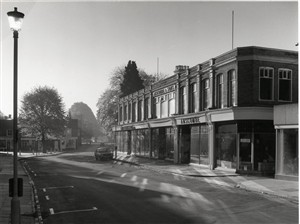
Anscombes Department Store closed in 1984 now Waitrose
Two years later Anscombe’s Department Store in Leyton Road closed. It was Harpenden’s oldest business, famous locally for its overhead cash rail system, which was in use until the final day. Waitrose opened on the site in 1983. As these larger shops opened, many smaller ones closed. The growth areas in Harpenden at present appear to be those providing financial services, and eating places, including numerous takeaways.
New public service
Public services have been changing too. In 1957 street lighting changed from gas to electricity. Gas had been supplied from the gas works at Southdown. With the advent of natural gas that site became redundant, and is now an industrial estate.
The Urban District Council’s Fire Brigade became part of the National Fire Service during the war. After the war, Fire Services became a County Council responsibility. A new Fire Station opened in 1992; the existing one, 90 years old, was demolished to give better access to James Marshall House and the Day Centre. In 1999 a new Police Station opened, replacing the original which had been in use for nearly a century. It closed for public access in 2012.
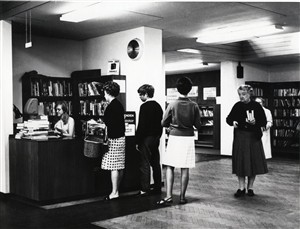
Harpenden Library 1967
The Red Cross staffed an emergency first aid centre at Victoria Road throughout the war. There was a proposal to demolish the old buildings, but in 1947 they were given new life when the Public Library transferred there from Harpenden Hall, and the Further Education Centre moved its classes there from Manland. In 1964 the Library doubled its size with an extension across the playground. [Eric Brandreth, who died shortly after writing this page, was Harpenden’s Librarian and custodian of its local history collection. In 2013 the library moved to the Woolworths/Argos site on Lower High Street, to make way for a Free School (Harpenden Academy) in the Victorian Board School buildings, which had been vacated in 1939 when the school moved to form Manland Junior School and Manland Secondary School (now Sir John Lawes School. ed]
A caring community
The Red House Memorial Hospital opened in 1941. The work of the Memorial Nursing Centre at 40 Luton Road was transferred to it, and the Centre was promptly requisitioned by the Army, who billeted members of the ATS there. The hospital became part of the National Health Service in 1948. As the policy of concentrating facilities into larger units developed, the maternity ward was closed in 1985, despite strong and vociferous protests from Harpenden residents.
Harpenden has long been a caring community: during the war various organisations raised funds, particularly for the hospital and for local service people. When the Welfare State was created in 1948, a public meeting was called to consider whether there might still be a need for such activity in the future.
To foster and encourage the spirit of service
From this meeting the Harpenden Trust was formed. Its aims were to foster and encourage the spirit of service in the community, to help and residents who may be in need and to raise funds so that the work may be well done. The Trust has more than fulfilled those aims for the past 60 years. Persuading the County Council to build a Day Centre in Rothamsted Park to be managed by Harpenden itself is just one of its achievements.
The National Children’s Home came to Harpenden in 1910 but new patterns of child care caused it to close its home at the Oval in 1985.

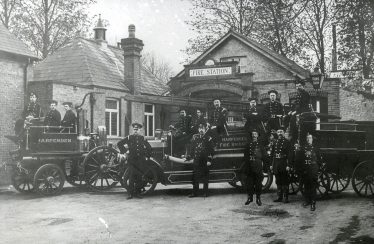
Comments about this page
I was born in St Albans hospital 1948. My home was a Nissen hut in Cowper Road. Moved to Fulmore Close, Batford and lived there until I was 14, then moved down to Tallents Crescent with my mother. She worked in a sweet shop called San Toy on Church Green, opposite a coffee bar called La Capri. She was also the treasurer of the youth club in Tallents Crescent. I remember going to one in the Methodist Chapel when I was 12. So many memories! Oh! I went to Roundwood Park School and had a sister Gillian one year older than me.
If Batford was incorporated into Harpenden in 1935 then surely the first supermarket in Harpenden was the Luton Co-op Society at the bottom of Pickford Hill which was opened in the early 50s. I remember our account number was 45010…….
Does anyone remember the little brown van that used to run around the village with a coffee pot on the top??? I remember the shop that operated this in the Lower High Street, it used to have coffee grinders in the front window. Just cannot remember the name of the business even though my father worked there at one time -probably about 1956.
ed: This was Harridens, who also had a coffee roaster – we remember the aroma! And we think we may have a photo of the van buried in our archives.
I remember the Consumer Tea Co and I have visions of wood not tiles.
Hey just seen the comment by Simon Darby abouts Ketts. Well Mr Darby, it’s Mr Mead “the madman” that took you on!
Just like to say thank you for my memories. I was born in Batford in 1954, I left school at 15 years old, and my 1st ever full time job was in Anscombes.
Sainsbury’s was not built on the site of the old C&A’s but beside it on the site of the old Broadway Hall covered market. The building next to the site, and between Sainsbury’s and C&A used to be the electrical showroom of Northmet.
Regarding the first supermarket, in the early 90’s I used to work for the electrical retailer Ketts (part of Rumbelows) at what is now The Slug and Lettuce. During a bit of refurbishing we discovered the left hand wall (looking from outside towards the back of the bar) had a mosaic and it was said that this used to be Sainsburys. This was obviously wrong but I wondered if anyone knew what was in there before Ketts. Also some may like to know that the current Sainsburys was built on the old C&A store which moved next to the George when they left the old place. As a kid I used to love going to the wood sheds out the back of C&A (where the lower part of the rear car park is now) as you could pretty much find any bit of wood you required. It was an early form of B&Q.
Ed. We think that Consumer Tea was on the site which was redeveloped as Rumbelows/Ketts. Did anyone take pictures of the mosaic?
Regarding the prisoner of war camp in Batford, my mother remembers that the Italians, unlike the Germans later, had no intention of escaping and therefore were allowed out for much of the day and used to do gardening and small jobs for the residents of Batford.
Regarding the item about Comfy Cars, my youngest uncle, Horace Longland of St.Albans was a driver for the company from 1930 to 1933. He then went on to become a driver for London Transport from the St Albans garage until retiring in 1946. He then bought a shop in Brocket Road, Stanborough, which finally closed as a shop in 1957. The shop was converted into a house where he continued to live until 1964 when he moved to Golden Riddy in Leighton Buzzard.
Add a comment about this page